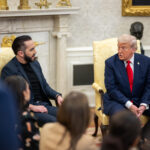Presidents Xi Jinping of China and Vladimir Putin of Russia met in Uzbekistan on Sept. 15 to attend the Shanghai Cooperation Organization conference, which includes Pakistan, India, Iran, and Central Asian states. While Xi and Putin posed for photo ops, one couldn’t help but wonder about the state of the United States and its alliances.
The United States seems apathetic toward the Quadrilateral Security Dialogue (also known as the Quad) and is inattentive to its NATO allies. In a world where only about 45% of countries are considered democracies and the Belt and Road Initiative is in full effect, the United States should not presuppose the alignment of non-treaty “allies” or assume that unaligned states are opposed to aligning with China or Russia. Regarding NATO allies with Article 5 commitments, the United States should ensure their readiness to win a war where a two major regional contingency model military would be tested.
Issues with American alliances and alignment result in a weakened defense against authoritarianism but this could change if the United States were to reevaluate its relationship with, and the role of, both NATO and the Quad.
US PROBLEMS WITH NATO
NATO’s defense spending problem still isn’t resolved four years after President Donald Trump brought the issue to the forefront. Member states have a 2%-of-GDP defense spending threshold, and they’re not reaching it. The decision to enact the threshold was made in 2006 and reaffirmed in 2014. This means that, individually, 2% of every NATO member’s GDP should be allocated to their own defense, which collectively results in a stronger NATO. Some countries have made some progress, but 19 out of 30 member states still fall short of the designated threshold 16 years after the decision was originally made. Germany, Europe’s largest economy, is by far the most “named and shamed” for this shortcoming and is likely to trend downward in its defense spending as we move closer to 2030. Meanwhile, NATO 2030 is rightly self-identifying as a “higher level of ambition” for the alliance and requires member states to increase both “national defense expenditure and NATO common funding.”
It’s time the United States set aside its commitment issues and clear its stance against autocracy through actions that strengthen alliances and create a convincing deterrent to great power rivals.
It’s clear the United States should play hardball regarding collective defense and other member states’ financial contributions. But it is also reasonable to assert that the ability to play hardball starts with a good relationship with our allies. In the United States’ own FY 2023 budget justification submitted to Congress for the NATO Security Investment Program, the Office of the Under Secretary of Defense (Comptroller)/Chief Financial Officer states: “The United States leads the key discussions within NATO, and the US contribution to common funded programs is essential to a continued leadership role.” The Biden administration would like to think that it has restored the United States of old, then it decides to make an exit from Afghanistan that’s mired in controversy. Who’s surprised when US allies observe that and question their importance to the United States?
A Washington Post article recounts that situation quite well. Tobias Ellwood, chair of the Defense Committee in the British Parliament, would say: “Whatever happened to ‘America is back’?” Cathryn Ashbrook, director of the German Council on Foreign Relations, added: “We’re back to the transatlantic relationship of old, where the Americans dictate everything.” Barbara Bodine, former US Ambassador to Yemen, likely said it best: “America is back, diplomacy is back, we can come back to the table and everyone will want us back at the table — Ukraine is a great example — but we don’t necessarily get the daddy chair anymore.” This is only the tip of the iceberg for improving NATO’s lethality: demanding basic accountability by building strong relationships and being a reliable, respected partner.
US AMBIVALENCE TOWARD THE QUAD
The Quad had a rocky start in 2007 but was revitalized when Trump showed interest in it several years ago. Disquieting feelings toward China’s aggression sponsored this revitalization, yet the Quad has failed to put military security at the forefront of its priorities and even failed to mention China by name in its 2022 “Joint Leaders Statement.” The lack of formality and the presence of ambiguity make the alignment of the United States, Australia, India, and Japan seem feckless and unthreatening. If the four countries can’t even decide what their relationship is, how can they be expected to win a war in the Pacific?
Mallory Shelbourne provides a good analogy: “If deterring China in the Pacific is a team sport, it might resemble a pickup basketball game more than the NBA.” In one of Shelbourne’s interviews, a Royal Australian Navy (RAN) officer describes how the RAN has been working toward interoperability with the US Marine Corps (USMC) since 2016. Yet, they faced an issue at the Rim of the Pacific Exercise (RIMPAC) 2022 where the USMC was using “magnetic north” while the RAN was using “true north,” meaning that USMC CH-53 Sea Stallions were flying with a bearing that was inaccurate by 10 degrees. These are the types of inefficiencies that must be ironed out before a kinetic military conflict with China. Nikolas K. Gvosdev explains US alignment ambiguity well, stating “Concepts like ‘strategic partnership,’ for instance, were coined in an effort to avoid having to make binding alliance commitments or to take on treaty-based obligations.”
The leaders of the Quad met for the second time in person this year but committed to meeting more frequently in the future. They keep asserting their commitment to a rules-based order in the Indo-Pacific but still boast no mutual defense treaty to enforce it. However, the informality of this “alliance” makes it laughable. And the United States has no idea where India stands.
From Sept. 1-7, India participated in a wargame with China and Russia in eastern Russia. The significance of cooperation between China and Russia lies in the fact that they offer different forms of authoritarianism and historically don’t cooperate in a “boots on the ground” manner. If they’re making an effort towards interoperability, it’s of the utmost concern to the United States. India, however, should be making plays toward interoperability with the United States, Japan, and Australia. The US bilaterally cooperates with India through numerous mediums, making their decision to partake in Vostok even more questionable. Their presence at this exercise should feel like a slap in the face and make everyone question the Quad’s foundation.
The Quad is not an alliance in the traditional sense, but it is a juvenile version of alignment meant to signify a convergence of policy. Formalizing the “security dialogue” into a real alliance, prioritizing defense spending and interoperability, and acknowledging the obvious threat to the Indo-Pacific that China poses would bolster the Quad’s ability to deter, but is not universally recognized as a good idea. Daniel DePetris writes, “Treating the Quad as an ideologically united bloc of democracies opposed to China’s authoritarianism is more rhetoric than reality.” He also argues that external powers “cannot reshape governance in China, and attempts to do so would diminish US prosperity and regional stability.” Yet, does this mean that the United States should neglect to prepare for a war that the Chinese may be preparing for?
China’s human rights violations, intellectual property theft, aggression toward their neighbors, goals of a China-centric world order, alignment with revanchist Russian belligerence, and other transgressions against the status quo warrant a certain degree of cooperation and caution by the United States. Therefore, the Quad should prepare to stop China from forcefully projecting its form of governance on US allies and partners. Wargames show that one of the US’ most significant advantages in a conflict with China would be its partners, so the Quad should be ready to leverage that advantage.
PRIORITIZING ALLIANCES
As China is building its military and formalizing its alliances through basing strategy in Djibouti, Cambodia, and potentially the United Arab Emirates, its goals are clear. This also goes for Russia, especially as it hosts China and India in a large-scale military exercise. NATO member states know where Putin stands as he wages war against Ukraine. Yet, the United States, a NATO ally, seems unreliable and inconsistent on the other side of the Atlantic.
It’s time the United States set aside its commitment issues and clear its stance against autocracy through actions that strengthen alliances and create a convincing deterrent to great power rivals. This means playing a more active role in NATO, consulting member states (at the very least) about decisions, and holding them accountable when they aren’t upholding their commitments. In the Pacific, it means formalizing the Quad to promote interoperability and possibly bolstering our partners’ defense efforts through written agreements and a higher frequency of practical exercises and personnel exchanges. It also means having clear guidelines that would preempt bad situations, like the one with India, in the future.
Taking alliances seriously is a low-cost deterrence method the United States can’t afford to miss out on.
Ray Vawter is currently in a military pipeline for human intelligence. He has worked in defense research and counterterrorism analysis and actively contributes to Aethon Enterprises’ East Asia Desk.














